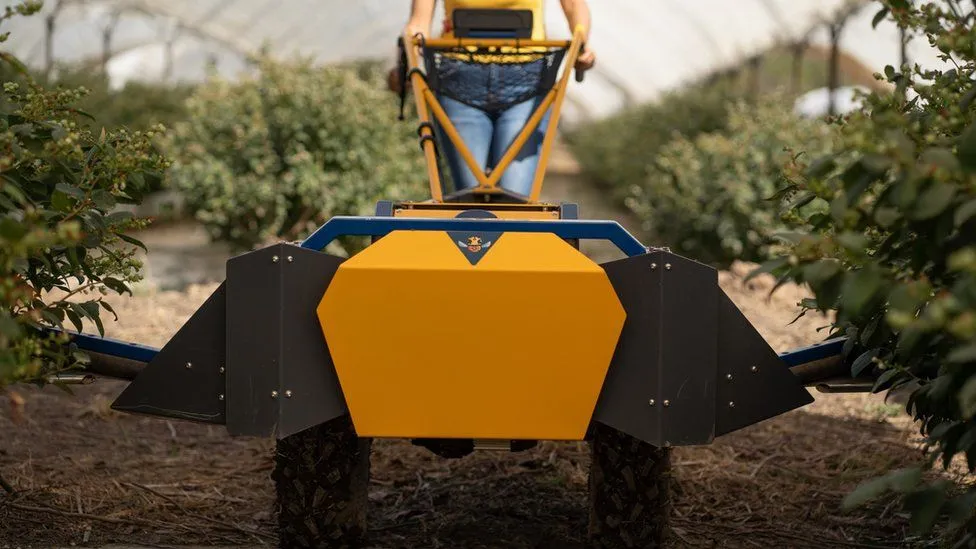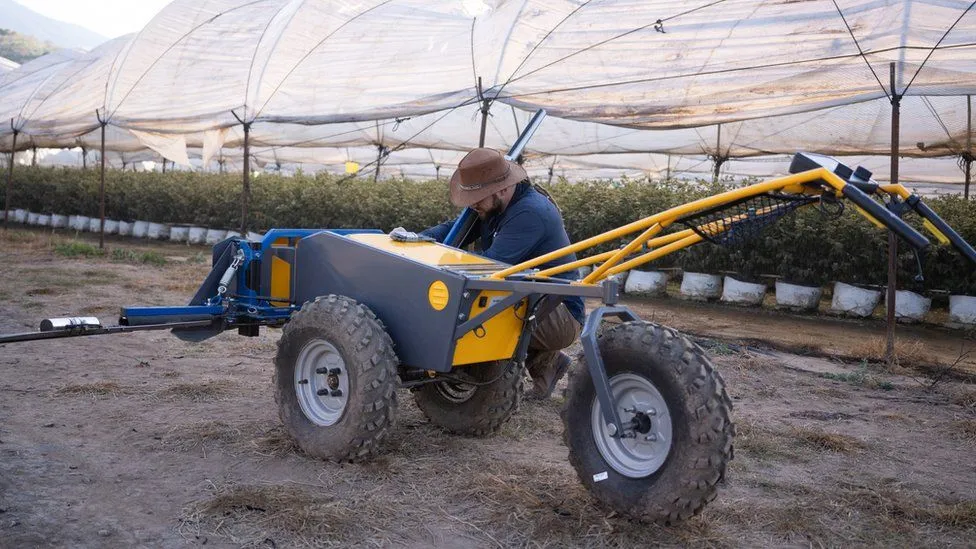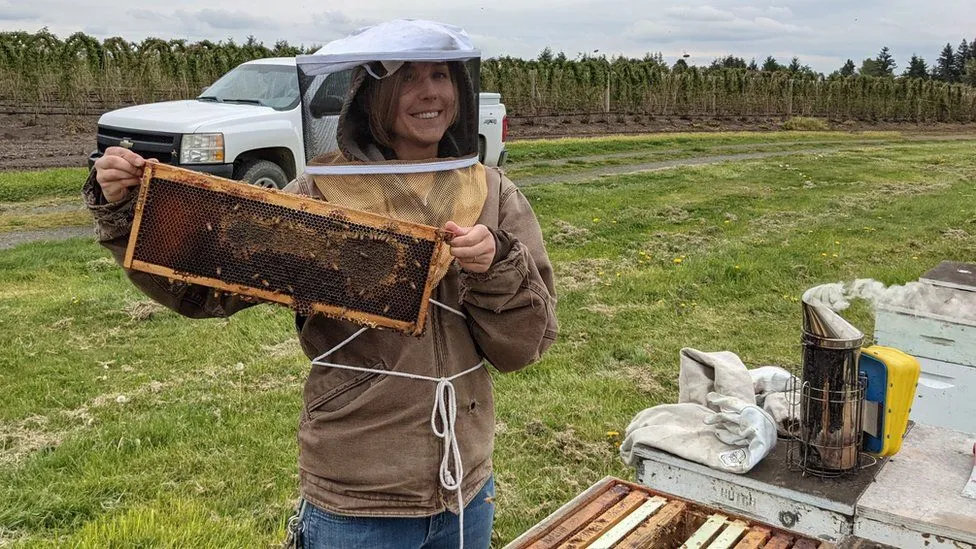The following news article covers the current stress of maintaining a sustainable rate of existing bees, as their population is struggling because of climate changes and aggressive farming. It covers how California has the biggest farm of almonds and how they are destroying the bee population to maximize profits.
https://www.bbc.com/news/business-66807456

A worker pushing BloomX’s Robee plant pollinator
In the scorching morning heat Thai Sade brushes the avocado trees he will soon artificially pollinate.
Based on a moshav, or collective farm, in central Israel, Mr Sade is the founder of tech firm BloomX. He says that the company has found a way to mechanically pollinate crops in a similar way to bees.
“We are not replacing bees… but rather, offering more efficient pollinating methods to farmers, and reducing the dependence on commercial honeybees,” he says.
Three out of every four crops grown around the world to produce fruits or seeds for human consumption are reliant, at least in part, on pollinators. And it is bees, be they farmed honeybees, or the more than 20,000 different wild bee species, such as bumble bees, that do the heavy lifting.
In the US, bees of all sorts are said to account for 75% of the pollination of the fruits, nuts and vegetables grown in the country. It is a similar percentage in Europe, with other insects, such as wasps and butterflies, making up the remaining quarter.
Unfortunately for farmers, bee populations are under pressure, due to factors such as climate change, habitat loss and the use of pesticides. The European honeybee is also being badly affected by a parasitic mite called varroa destructor.

Habitat loss is putting the bee population under pressure
BloomX’s technology is currently aimed at two crops - blueberries and avocados - and allows them to be pollinated even if local bee numbers are very low.
The firm’s main products is called “Robee”, which at first glance looks like a large push-along lawnmower. It has two mechanical arms that stick out either side.
These vibrate, and when brushed over blueberry plants, they cause them to release their pollen. The level of vibration is said to have been designed to imitate that of bumble bees - the most effective pollinators of blueberries - which use their wings to agitate the flowers.
BloomX’s other product is “Crossbee”, a handheld tool for collecting and spreading sticky pollen grains between avocado trees. To date the equipment is being used in South America, South Africa, Spain, the US and Israel, and BloomX says it can increase fruit yields by 30%.
Both products are controlled by an AI-based software system linked to a mobile phone app, and each is fitted with a GPS tool so that farm workers know which areas of a field have been treated.
Sensors can also be put in place so that the pollination takes place on the optimum days.

BloomX’s technology is now being used on farms in various parts of the world
In California, the cultivation of almonds is a huge business. The state producers 80% of the world’s almonds, and the industry is worth an estimated $10.4bn (£8.3bn) a year.
To fertilise the total 1.3 million acres of these trees, honeybees are trucked to California from across the US for the almond flowering season. Some reports say that 70% of commercial US honeybees are taken to the state for this purpose.
Lisa Wasko DeVetter, an associate professor of horticulture at Washington State University, says that this can mean a shortage of honeybees elsewhere in the US for other crops. Artificial pollination may be able to help fill this gap.

Lisa Wasko DeVetter checking a hive of bees
“Travel can stress honey bees and weaken colonies, but the business of pollinating almonds is hugely important for beekeeper income, and keeping their operations economically viable,” she says.
“However, the impact on other crops is that honey bees may be in short supply if other crops have bloomed at a time that coincides with the California almond industry.”
Other commentators point to the high mortality rate of honeybees in the almond fields, with beekeepers blaming exposure to pesticides, and the stress of their hives being transported thousands of miles.
In addition, Mr Sade says that such intensive use of honeybees “poses a threat to indigenous wild bees who are forced to compete for food, and are exposed to new diseases”.
Introducing some artificial pollination to the almond fields may help lesson all these problems. That’s certainly the view of Eylam Ran, who says “we are pushing bees into places they shouldn’t be in real life”.
Mr Ram is the boss of another Israeli tech firm specialising in artificial pollination - Edete.
The core of its technology is its ability to store pollen for several years without it deteriorating. To do this it has developed machinery to collect and then apply the pollen.
“We can bring the best pollen at the best time for the flower to get pregnant.” says Mr Ran “We can do it for apples, cherries, almonds, pistachios, and our machines fertilise with precision.”
So far Edete’s technology is mainly being used in California on pistachio fields, but they are also now starting on almonds.
Mr Ran says it is good news for bees. “Industrial monoculture is not a place for insects to flourish. On the contrary - it is killing them.”
He adds: “Not forcing bees into crops they do not naturally feed on will ease the pressure on them, and allow them to go back to the way they should harvest naturally, while still allowing us to get our need for fruits and vegetables.”
Diane Drinkwater from the British Beekeepers Association (BBKA) counters that “if bee health and welfare are prioritised, then the need for artificial pollination is largely unnecessary”.
“Bees have been pollinating fine for millions of years mainly for free, except for the bribery offered by the flowers in the form of nectar,” she adds. “Some high density crops however benefit from migratory pollination which supports many commercial beekeepers’ livelihoods.
“BBKA supports all pollinators, especially honeybees. They are perfect pollinators providing a workforce which can be moved to pollinate early crops which can increase yields. And honeybees need the nectar and pollen they collect whilst pollinating to feed the honey bee population and to get them through winter.”